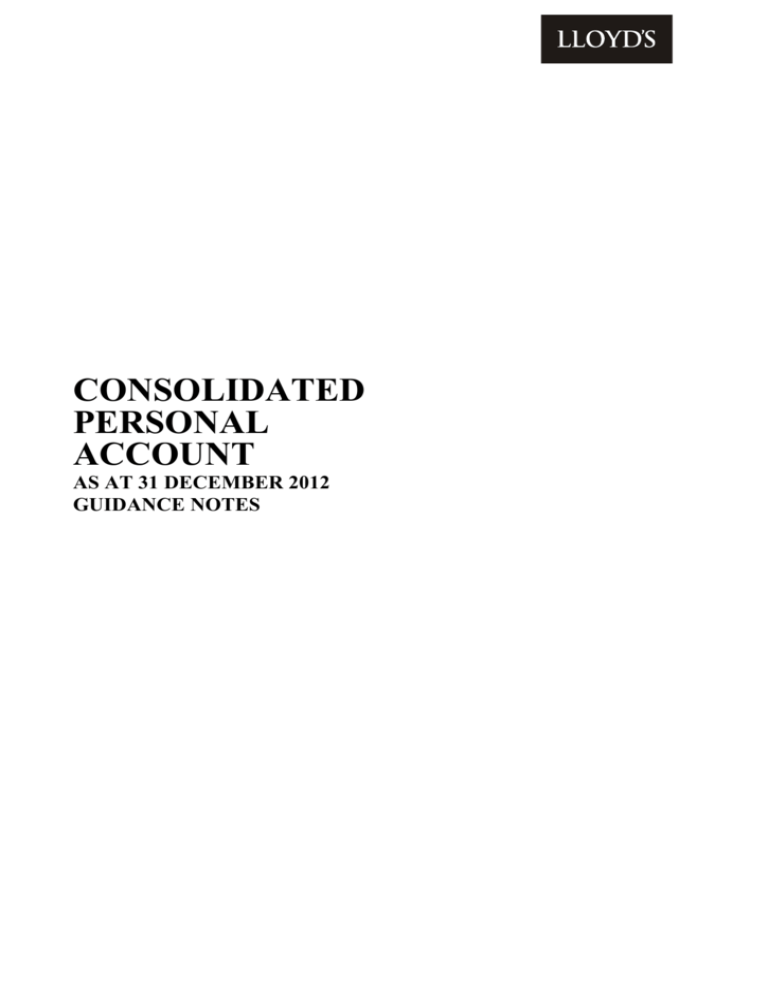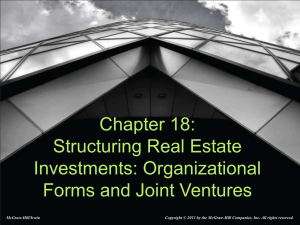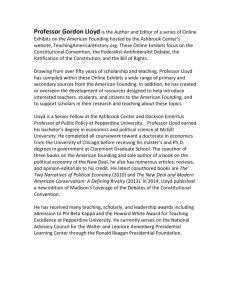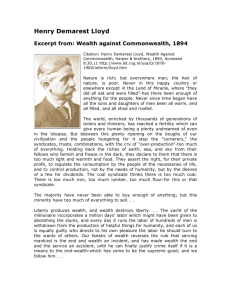consolidated personal account
advertisement

CONSOLIDATED PERSONAL ACCOUNT AS AT 31 DECEMBER 2012 GUIDANCE NOTES Contents Page Introduction 2 Chapter 1: Interpreting your Consolidated Personal Account 3 1.1 Overview 3 1.2 Content of the Consolidated Personal Account 5 Chapter 2: Audit of Personal Accounts and Syndicate Mapa Accounts 11 2.1 Review by Ernst & Young 12 2.2 Statement by Lloyd’s Management 14 1 INTRODUCTION Your Consolidated Personal Account (CPA) provides you with a full breakdown of your underwriting results, as at 31 December 2012, into their component parts. These notes provide an explanation of the CPA and have been designed to draw your attention to certain key elements. The CPA has been prepared by Lloyd’s Market Services (MS) using information provided by managing agents in respect of individual syndicate or Members’ Agent Pooling Arrangements (MAPA) participations. This has been aggregated into a single document. There are, however, other elements that are relevant to your underwriting affairs, such as members’ agent’s fee adjustments and commissions, overseas income tax, solvency retentions, transfers to or from the Special Reserve Fund, and MS charges. These are not included in the CPA and will be reported in a separate distribution cash statement prepared by your members’ agent. This distribution cash statement will normally accompany your CPA. Syndicates report their results on an annually accounted basis, using UK Generally Accepted Accounting Practice (UK GAAP). In addition, they prepare accounts on an underwriting year basis in respect of closed and run-off years of account. The format of the CPA has been designed to reflect the format of the syndicate underwriting year accounts as at 31 December 2012. A full 36-month period is reported within the CPA in respect of the 2010 underwriting account. Results for syndicates in run-off cover the latest 12-month period. Under UK GAAP, syndicates are able to select from a wider range of accounting policy choices in the preparation of their accounts than was previously available under the Lloyd’s three-year accounting basis. It is therefore recommended that you refer to the relevant syndicate accounts for full details of the policies adopted therein. Please note that the CPA reflects the results reported by syndicates and does not take into account any member’s tax liabilities arising from their membership of Lloyd’s. It is your personal responsibility to agree and settle your taxation liabilities with all relevant tax authorities. You are therefore advised to consult with your own advisors on such matters. The format of the CPA is detailed below: Summary Schedule Schedule 1 Schedule 2 Schedule 3 Schedule 4 Schedule 5 Appendices I to IV Open/Run-Off Accounts 2010 account – syndicates closing 2010 account – syndicates in run-off 2009 and prior accounts – syndicates closing 2009 and prior accounts – syndicates in run-off Summary of uncalled & undistributed amounts Details of expenses and investment return in support of schedules 1 to 4 Cash movements (due)/releasable in June 2013 Please note that profits will be available for release from 1 May 2013. Members’ agents may have given their members the option to receive only the summary schedule and the Open/Run-Off Accounts information. If this is the case, the only relevant pages of these Guidance Notes are pages 5 - 7 and page 10. We are pleased to advise that the following syndicates, which remained in run-off as at 31 December 2011, have been able to effect Reinsurance to Close settlements during 2012: Year of Account 2008 2009 Syndicate 0260 0260 In addition, the following 2010 account syndicates have gone into run-off as at 31 December 2012. Year of Account 2010 Syndicate 0779, 1965, 5820 2 CHAPTER 1: INTERPRETING YOUR CONSOLIDATED PERSONAL ACCOUNT 1.1 OVERVIEW Summary Schedule The summary schedule summarises your share of syndicate results declared as at 31 December 2012 from direct participations and through MAPAs. The results include the overall result at 36 months in respect of the 2010 year of account, together with the calendar year movement on 2009 and prior run-off years of account. If you underwrote through a MAPA, you will also receive a report from your MAPA operator, which will provide an analysis of the underlying syndicate results that comprise the MAPA. Schedules 1, 2, 3 and 4 These four schedules provide the details of your share of each of your syndicates’ results as at 31 December 2012 and, where you participated on or through a MAPA, your share of the results of the MAPA. Your results are shown in the same constituent parts as on the summary schedule and are split according to the year of account and whether the syndicate has closed or is in run-off as at 31 December 2012. The syndicate and MAPA numbers are shown together with your percentage share of each syndicate, your syndicate premium limit or MAPA participation, and your result applicable to each syndicate. Members participating on a MAPA with run-off syndicates, where the result for the period is not being called, may find a small balance of up to 5 pence is being reported because of rounding. The currency analysis for MAPA results is correctly calculated as zero. Schedules 3 and 4 include the movement for the calendar year but also include extra columns giving details of the cumulative position reported by run-off syndicates up to 31 December 2011, together with the cumulative position carried forward as at 31 December 2012. Please note that cumulative cash calls or distributions made in previous years are not shown. Each of these schedules has an overall total, which is carried onto the summary schedule. The layout of schedules 1 to 4 is the same as that used for the summary schedule. Appendices I, II, III and IV Each of the four schedules (1, 2, 3 and 4) has a corresponding appendix providing details of the expenses, investment return and profit commission that contribute to your overall result. As with the schedules, these relate to: Appendix I: 2010 account – syndicates closing Appendix II: 2010 account – syndicates in run-off Appendix III: 2009 and prior accounts – syndicates closing Appendix IV: 2009 and prior accounts – syndicates in run-off Schedule 5 Schedule 5 provides totals of all the uncalled and undistributed amounts being carried forward as at 31 December 2012. 3 Open/Run-Off Accounts Cash Movements (Due)/Releasable In June 2013 This schedule provides a breakdown of all the open year and run-off syndicates making a release of profit or a cash call, as reported to MS by the end of March 2013. Any calls or releases advised after this date will not be shown; however, they should be advised via your distribution cash statement issued by your members’ agent. Please note, these amounts do not form part of the summary schedule. They are provided for information only in order to give a little more detail on the overall results for the current distribution. 4 1.2 CONTENT OF THE CONSOLIDATED PERSONAL ACCOUNT Summary Schedule and Schedules 1, 2, 3 and 4 The constituent parts of your underwriting result are shown on your statement. Please note that the letters shown below relate to the letters alongside the description on the CPA itself. A) Balance on general business technical account (excluding investment return) This represents your share of net premiums receivable, reinsurance to close premiums received or (for 2009 and prior run-off syndicates) the amount retained to meet all known and unknown outstanding liabilities as at 1 January 2012, less net claims and reinsurance to close premiums payable or (for run-off syndicates) the amount retained to meet all known and unknown liabilities as at 31 December 2012. (Please note that the result is shown after charging expenses shown at line B, but prior to investment return.) In relation to the syndicate underwriting accounts, this should correspond to Balance on technical account – general business plus net operating expenses less investment income transferred from the non-technical to the technical account. B) After charging: Expenses Details of expenses are provided on the appendices to each schedule, and the overall total is shown on the summary schedule. C) Investment return Details of the investment return are provided in the appendices to each schedule and the overall total is shown on the summary schedule. D) Non-standard personal expenses Details of the non-standard personal expenses are shown on the appendices to each schedule, and the overall total is shown on the summary schedule. E) Net result for the period Your net result for the period is the sum of: A) Balance on general business technical account C) Investment return, and D) Non-standard personal expenses. F) Release of interim surpluses in 2012 Syndicates are permitted to make releases of open year profits to members. A 2010 year of account syndicate will have been permitted to make releases during 2011 and/or 2012, and any amounts released will be shown on schedules 1 and 2. 2009 and prior syndicates will only report releases made during the 2012 calendar year. The summary schedule shows the aggregate of all such releases detailed on schedules 1 to 4. G) All cash calls up to 31 December 2012 This section provides details of any cash calls made within the period being reported (36 months for 2010 account and 12 months for 2009 and prior syndicates). For 2009 and prior syndicates, any calls shown within last year’s CPA will not be shown as they were accounted for as at 31 December 2011. H) Other cash calls due prior to loss payment date The amount of any cash call made between 1 January 2013 and 14 June 2013 for syndicates that closed as at 31 December 2012. I) Total after cash releases/calls The total after cash releases/calls is the sum of: E) Net result for the period F) Release of interim surpluses in 2012 G) All cash calls up to 31 December 2012 and H) Other cash calls due prior to 14 June 2013. 5 J) (Uncalled)/Undistributed amounts brought forward as at 1 January 2012 This section provides details of any 2009 and prior run-off syndicates that had uncalled deficits or undistributed surpluses brought forward from last year’s CPA. Please note that uncalled deficits will be shown as negative amounts and undistributed surpluses as positive amounts. K) Exchange rate adjustments to brought-forward amounts No syndicates in run-off as at 31 December 2011 restated their brought-forward balances to reflect unrealised exchange profit/(loss) arising on the retranslation of early PTF releases or cash calls that were made in previous accounting periods. L) Uncalled/(Undistributed) amounts carried forward as at 31 December 2012 This section provides details of any uncalled deficits or undistributed surpluses carried forward to next year’s CPA. Please note that uncalled amounts will be shown as positive amounts, undistributed surpluses will be shown as negative amounts. M) Net amount of surpluses/(deficits) called in 2012 The net amount due to or from you, subject to any further adjustments set out in your members’ agent’s distribution cash statement. N) Surpluses to be released in 2013 The total of all surpluses being released to you as part of the 2010 account distribution. O) Deficits to be called in 2013 The total of all deficits to be funded by you as part of the 2010 account distribution. P) Net amount due to/(from) member This is the total sterling amount due to or from you as at 31 December 2012 (amounts due from you are negative). However, a breakdown by currency and fund is shown in sections Q to S below. The net amount to be carried forward to your members’ agent’s distribution cash statement in currency The amount to be distributed or collected by syndicates is shown initially in sterling. However, the actual amounts to be distributed or called will be in sterling and US dollars. With effect from 1 August 1995, a new trust fund for US dollar business was set up, the Lloyd’s Dollar Trust Fund (LDTF), and the existing fund, the Lloyd’s American Trust Fund (LATF), ceased to receive premiums for non-life business incepting after 31 July 1995. In April 2009, the non-life LATF accounts were closed with all balances being transferred to the LDTF. However, the Life LATF still exists and, because of the differing requirements governing the release of US dollars to members, it is necessary to separately identify the fund to or from which US dollars are being called or released. Managing agents determine the amounts to be distributed or collected in currency from each trust fund for each syndicate that they manage. The rate of exchange used is generally that applying as at 31 December 2012, which was US$1.63 = £1; however, since the change to UK GAAP, some syndicates may use a slightly different rate to this. The amounts shown in the currency analysis at the foot of your summary schedule will be carried forward to your distribution cash statement prepared by your members’ agent. The distribution is in currency; consequently, members bear the exchange risk if there is a difference between the rates as at 31 December 2012 and the rate prevailing at the date when the dollars are actually distributed or converted to sterling for distribution. The following life syndicates are making a distribution in LATF US dollars whilst also making a cash call in sterling. This arises where a syndicate has a currency imbalance and surplus LATF US dollars could not be sold by the syndicate under the terms of the Lloyd’s American Trust Deed. Under these circumstances, managing agents must redress such a currency imbalance by distributing LATF US dollars in excess of the reported profits and making a cash call equivalent to the excess distribution. Year of Account 2010 Syndicate 3002, 3622 Q) £ This is the amount due to or from you in sterling. 6 R) US$ – Lloyd’s American Trust Fund This is the amount due to or from you in US dollars where the business has originated within the Lloyd’s American Trust Fund. This applies to Life syndicates only. S) US$ – Lloyd’s Dollar Trust Fund This is the amount due to or from you in US dollars where the business has originated within the Lloyd’s Dollar Trust Fund. Appendices I, II, III and IV Expenses Acquisition costs Acquisition costs, including brokerage and commissions, are shown. Up to 31 December 2004, these generally appeared on the CPA within the underwriting result, while as at 31 December 2005, these were reported as syndicate operating expenses. Within the current CPA, these are being reported as a separate expense; however, please note that the cumulative amounts brought forward onto appendices III and IV may still be shown as they were originally reported. Syndicate operating expenses These represent expenses incurred by the managing agent and charged to the relevant syndicate years of account. Syndicate underwriting year accounts provide further information on the basis adopted by managing agents for allocating expenses between years of account. Lloyd’s Central Fund contributions These were charged for the 2010 year of account at 0.5% of your syndicates’ total written premium. New corporate members paid increased contributions of 2% for each of their first three years of operation. A new corporate member is one that joined Lloyd’s in 2010 and established or participated on one or more new syndicates, thereby immediately accessing the Lloyd’s brand, reputation and accumulated value of the Central Fund. It should be noted that if the member wrote on a mix of existing and new syndicates, then the higher rate would only be payable in respect of its participation on new syndicates. Lloyd’s subscriptions Lloyd’s subscriptions for the 2010 year of account were 0.5% of your syndicates’ total written premium. Managing agent’s fees These fees are charged by managing agents in accordance with your agency agreements. The fee payable to each managing agent in respect of each participation is normally a percentage of your syndicate premium limit. Managing agent’s profit commission These fees are charged by managing agents in accordance with your agency agreements. Profit (loss) on exchange Your share of any profits and losses on syndicate currency transactions are shown. These arise because syndicates maintain a number of separate currency funds, including sterling, US dollars, euros and Canadian dollars. Items expressed in these currencies are translated into sterling at the prevailing rates applicable to the syndicates. Please refer to the syndicate accounts for details of the exchange rates applying to each syndicate. B) Total expenses The sum of all the expenses detailed is shown on line B of the relevant schedule. (Please note that the Balance on the general business technical account is the amount after charging your expenses shown at line B). If you underwrite through a MAPA, you may find that certain standard personal expenses charged exceed the normal percentages quoted. This arises because the syndicate MAPA capacity on which contributions are based is not adjusted to reflect the deaths of members of the MAPA during 2010. Such deceased members do not participate in the results of the syndicates making up the MAPA, and their shares are taken over by the remaining members. Consequently, the remaining members are responsible for an increased share of the underwriting results and expenses of the MAPA. 7 Investment return Investment income Investment income is the return, excluding capital gains and losses, earned on investments allocated to the relevant year of account. Investment gains less losses These are capital gains and losses allocated to the relevant year of account. Investment expenses, charges and withholding tax Investment expenses and charges represent investment managers’ fees and expenses together with other charges allocated to the relevant year of account. C) Total investment return The sum of all the investment items detailed is shown on line C of the relevant schedule. Non-standard personal expenses Members’ agent’s fee advances Where appropriate, members’ agent’s fee advances paid from syndicate funds in respect of the 2010 year of account are shown. These do not necessarily represent all members’ agent’s fees, and an adjustment may be required on your distribution cash statement, prepared by your members’ agent, to bring the fee advances into line with the amounts to be charged under the members’ agent’s agreement. Under the current accounting regime, members’ agent’s fee advances are generally shown only as a balance sheet item and are not included within the profit and loss account of the underwriting year accounts. Schedule 3 charges This item relates to the costs incurred by Lloyd’s in providing information to enable corporate members’ statutory financial statements to be prepared in accordance with Schedule 3 of the Companies Act 2006. Interest on late payment Where cash calls remain unpaid after the due date, under the terms of the managing agent’s agreement, agents are entitled to charge interest at a rate of 2% above the Bank of England base rate. Personal exchange rate adjustments Where cash calls are paid late by members and an exchange difference results on translation, syndicates may charge members for any loss incurred. Prior year adjustments Where syndicates have made an error in a previous closed year result, they may wish to make a correcting entry in the current distribution year; for example, if a syndicate applied the wrong rate of Central Fund contribution for corporate members then an adjustment may be made as a prior year adjustment. Other non-standard expenses There are a number of other non-standard personal expenses that are applicable to certain members of a syndicate. They may include the following: Personal adjustments This is where a syndicate has an ad-hoc expense/credit that needs to be applied to a specific member. These could include run-off management fees and specific letter of credit charges or brokerage fees. Administration charges made by Lloyd’s These fees were charged to syndicates by Lloyd’s in order to cover the cost of results processing on behalf of syndicates. For the 2010 year, the costs were: i) For active aligned/dedicated syndicate £1,195 ii) For open/run-off/closing aligned/dedicated syndicates £1,050 8 iii) For active spread syndicates without any MAPA involvement £2,380 iv) For open/run-off/closing spread syndicates without MAPA involvement £2,100 v) For active spread syndicates with MAPA involvement £3,500 vi) For open/run-off/closing spread syndicates with MAPA involvement £3,080 It should be noted that syndicates can treat these charges, which are subject to VAT, in different ways. For example, some syndicates have shown these costs as part of syndicate operating expenses rather than as personal expenses. As a result, you may not see these charges being reported separately on your CPA for all syndicates on which you participate. D) Total non-standard personal expenses The sum of all the non-standard expenses detailed is shown on line D of the relevant schedule. Members should note that non-standard personal expenses may be reported through their co-ordinating agent, despite the fact that certain of the syndicate allocations giving rise to such adjustments may have been arranged through a class or subordinate agent. This is to simplify the reporting of such items. Calculation of result for profit commission The appendices show the results on which managing agents have charged profit commission in accordance with the agency agreements. The total commissionable result is a memorandum field supplied by managing agents giving details of the result on which profit commission has been charged before applying any adjustments for deficits brought forward from previous years. Such deficits will be applied to these results where necessary under the terms of the deficit clause within the Managing Agents Agreement and Register of Agent Charges. Members participating through MAPAs may notice that the amount of profit commission shown as a deduction from the MAPA result in appendix 1 looks out of line with the commissionable result being reported for the MAPA. This is because the MAPA commissionable result is the sum of all the results reported by the syndicates on which the MAPA participated, both profitable and loss-making, whereas the profit commission itself is derived solely from those syndicates reporting a positive result on which profit commission can be charged. Result for profit commission This is the actual result on which profit commission has been calculated. Schedule 5 Uncalled deficits for 2010 year of account are shown with a line reference of L1, while undistributed surpluses for 2010 syndicates are shown as L2. Uncalled deficits for 2009 and prior years of account are shown with a line reference of L3, while undistributed surpluses for 2009 and prior syndicates are shown as L4. The net amount of undistributed surpluses and uncalled deficits is carried forward to the summary schedule where the line reference is L. 9 Open/Run-Off Accounts Cash Movements (Due)/Releasable In June 2013 The report shows the open year releases and cash calls being made, by syndicate, in both sterling and dollars. For 2010 and prior years of account, these amounts are in respect of run-off syndicates, while for 2011 and 2012 years of account, these will be in respect of the naturally open years that have not yet reached their 36month stage. Overall totals at the bottom of the schedule should equal the amounts shown on your distribution cash statement; however, they do not appear on the summary schedule of the CPA. 10 CHAPTER 2: AUDIT OF PERSONAL ACCOUNTS AND SYNDICATE MAPA ACCOUNTS The CPA has been prepared by The Corporation of Lloyd’s using personal account and syndicate MAPA account information provided by managing agents. Information relating to members’ MAPA participations shown in the CPA has been derived from the relevant syndicate MAPA accounts by apportioning the results to the members of the MAPA based on Lloyd’s centrally held data of participations. Ernst & Young LLP has reviewed the procedures and controls used by The Corporation of Lloyd’s to prepare CPAs for Lloyd’s members as at 31 December 2012. A copy of its report is reproduced below. In order to gain a full appreciation of your results, it is recommended that you read your CPA in conjunction with the relevant syndicate accounts. In that regard, your attention is drawn to the fact that the audit reports issued in respect of the following syndicate underwriting year accounts contained emphasis of matter paragraphs in respect of various uncertainties, although these opinions were not qualified in this respect: Year of Account 2007 2008 2009 2010 Syndicate 2468 4000 1231, 1965 0779, 1301, 1965, 5820 All reports by the syndicate auditors on the systems employed by managing agents to produce personal accounts and syndicate MAPA data were unqualified. 11 2.1 REVIEW BY ERNST & YOUNG Report of Ernst & Young LLP to the Council of Lloyd’s We have reviewed the procedures and controls employed by The Corporation of Lloyd’s in producing consolidated personal accounts for Lloyd’s members as at 31 December 2012 pursuant to the provisions of the Syndicate Accounting Byelaw (No. 8 of 2005). This report is made solely to the addressee in accordance with the engagement letter dated 4 April 2012 (‘the instructions’). Our work has been undertaken so that we might state to the addressee of this report those matters which we are required to state in this report by the Instructions and for no other purpose. To the fullest extent permitted by law, we do not accept or assume any responsibility to anyone other than the addressees of this report, for our work, for this report, or for the opinions we have formed. Respective Responsibilities of the Council of Lloyd’s and Ernst & Young LLP As described in the attached Statement by Lloyd’s Management, Lloyd’s Management is responsible for the preparation of members’ consolidated personal accounts in accordance with the Lloyd’s Syndicate Accounting Byelaw. It is our responsibility to form an independent opinion based on our review and to report our opinion to you. Use of this report This report is intended solely for the use of the addressee. Ernst & Young LLP understands that the addressee may wish to make our report available to third parties, including members’ agents and members of Lloyd’s. We are not privy to the interests, technical knowledge and commercial or other objectives of these third parties. Hence, the specific needs and requirements of any such third parties have not been taken into account in preparing the report. Ernst & Young LLP assumes no responsibility whatsoever in respect of any negligence, fault, breach of contract or breach of duty or otherwise to any user of this report other than the addressee. Any other person who chooses to rely on this report does so entirely at their own risk. Basis of opinion Our review included such procedures as we considered necessary to evaluate whether the procedures and controls taken as a whole were operating with sufficient effectiveness to provide reasonable, but not absolute, assurance that members’ consolidated personal accounts have been properly prepared in accordance with the Lloyd’s Syndicate Accounting Byelaw. These procedures included examination on a test basis of evidence of compliance with the procedures and controls within the Central Distribution System under the direct management of The Corporation of Lloyd’s in respect of the preparation of members’ consolidated personal accounts. Our opinion relates solely to those procedures and controls and not to any others. Our procedures did not necessarily include tests of transactions for any particular member. Our review was limited to the Central Distribution System procedures and controls under the direct management of The Corporation of Lloyd’s. Procedures performed and controls operated by managing agents on the determination of members’ results did not fall within the scope of our review. Those procedures, controls and results have been reviewed by syndicate auditors who have provided separate reports. We have not audited those results. Consequently, we do not express an audit opinion on those results. Our review did not extend to the procedures and controls operated by management in the production of the Schedule “Open/Run-Off Accounts Cash Movements (Due)/Releasable in June 2013”. Inherent limitation Procedures and controls are subject to inherent limitations and, accordingly, errors or irregularities may occur and not be detected. Such procedures cannot be proof against fraudulent collusion, especially on the part of those holding positions of authority or trust. Furthermore, this opinion relates only to those procedures and controls operated in connection with the position as at 31 December 2012, and should not be seen as 12 providing assurance as to any future position, as changes to system or controls may alter the validity of our opinion. Opinion In our opinion, the procedures and controls taken as a whole provide reasonable but not absolute assurance that members’ consolidated personal accounts have been properly prepared, in all material respects, as at 31 December 2012 in accordance with the Lloyd’s Syndicate Accounting Byelaw. Ernst & Young LLP Accountants approved by the Council of Lloyd’s 30 April 2013 13 2.2 STATEMENT BY LLOYD’S MANAGEMENT We are responsible for the system of internal controls established in order to provide reasonable assurance of effective and efficient operations, and compliance with applicable laws and regulations. The system of internal control can provide only reasonable and not absolute assurance against material misstatement or loss. We are responsible for: i) Keeping proper accounting records that disclose with reasonable accuracy members’ consolidated results in respect of their underwriting at Lloyd’s ii) Sending to every members’ agent, for each member for whom it acts as such in relation to any syndicate, a consolidated personal account in respect of all such syndicates iii) Sending to every corporate member in respect of all the syndicates of which it is a member and in respect of which no members’ agent acts as such for it, a consolidated personal account iv) Ensuring balances are maintained in accordance with applicable Lloyd’s byelaws and applicable trust deeds, and v) Taking reasonable steps for the prevention and detection of fraud and other irregularities. We declare that: a) The procedures and controls operated by The Corporation of Lloyd’s were suitably designed to ensure that members’ consolidated personal accounts are properly prepared as at 31 December 2012, and b) The procedures and controls were operating with sufficient effectiveness to provide reasonable, but not absolute, assurance that members’ consolidated personal accounts are properly prepared as at 31 December 2012. 14






